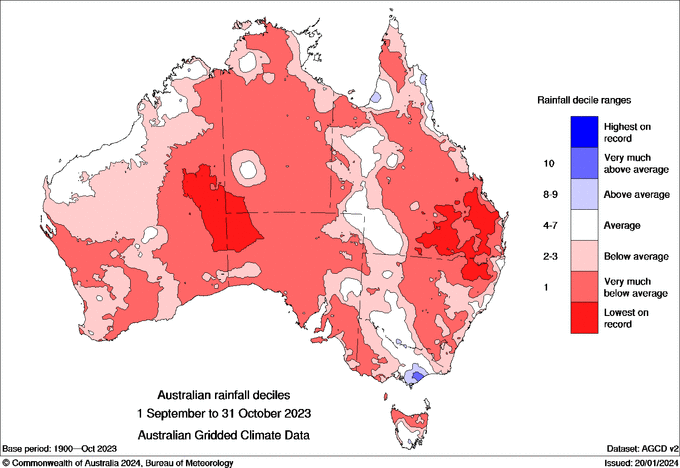- Queensland experienced over 1000 bushfires in late October 2023.
- The Western Downs region in south-east Queensland was significantly impacted, with the town of Tara losing more than 20,000 hectares of land to the fires.
In late October 2023, the state of Queensland experienced a series of bushfires, marking one of the earliest fire seasons since satellite records began in 2001. Over 1000 fires burned across the state, with significant fires occurring in the Western Downs region, located approximately 300 km west of Brisbane.
On 23rd October, multiple fires started in the Western Downs region and were rapidly pushed toward the town of Tara due to changing winds. These fires maintained their intensity over the following days resulting in Tara losing more than 20,000 ha of land by 29th October. On 31st October strong westerly winds and temperatures approaching 40°C further intensified the fires. The situation eased on 3rd November with the passage of several storms across the region and the arrival of much-needed rainfall.
The fires were unusual in two ways: they began early in the season and a greater number than usual continued to burn through the night. This atypical behaviour was caused by exceptionally hot and dry conditions, which are made more likely with climate change. These fires also coincided with the return of El Niño, which typically results in reduced springtime rainfall in eastern Australia. This was the case in 2023, which saw the driest September since 1900. These exceptionally dry conditions allowed plant regrowth from three consecutive La Niña years to dry out and become fuel for the fires.

The fires had devastating impacts, with 58 homes destroyed in Tara, surpassing the toll of the Black Summer fires of 2019 across the whole of Queensland. Nearly 300 people were forced to evacuate their homes and two people died. Queensland’s firefighters received substantial support, with more than 80 firefighters arriving from Victoria and 27 crews coming from New Zealand.
In the future, south-east Queensland is expected to face harsher fire conditions due to global warming. Modelling conducted by CSIRO and the Bureau of Meteorology shows that the region is likely to experience large declines in rainfall in the coming decades. These projected drier and hotter conditions may result in higher fire risks for the area.
The ARC Centre of Excellence for Climate Extremes is researching how different atmospheric processes, such as the transport of dry air, contribute to fire events.
Research contacts:
Laure Poncet, l.poncet@unsw.edu.au
Dr Doug Richardson, doug.richardson@unsw.edu.au Professor Andy Pitman, a.pitman@unsw.edu.au
